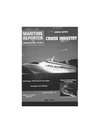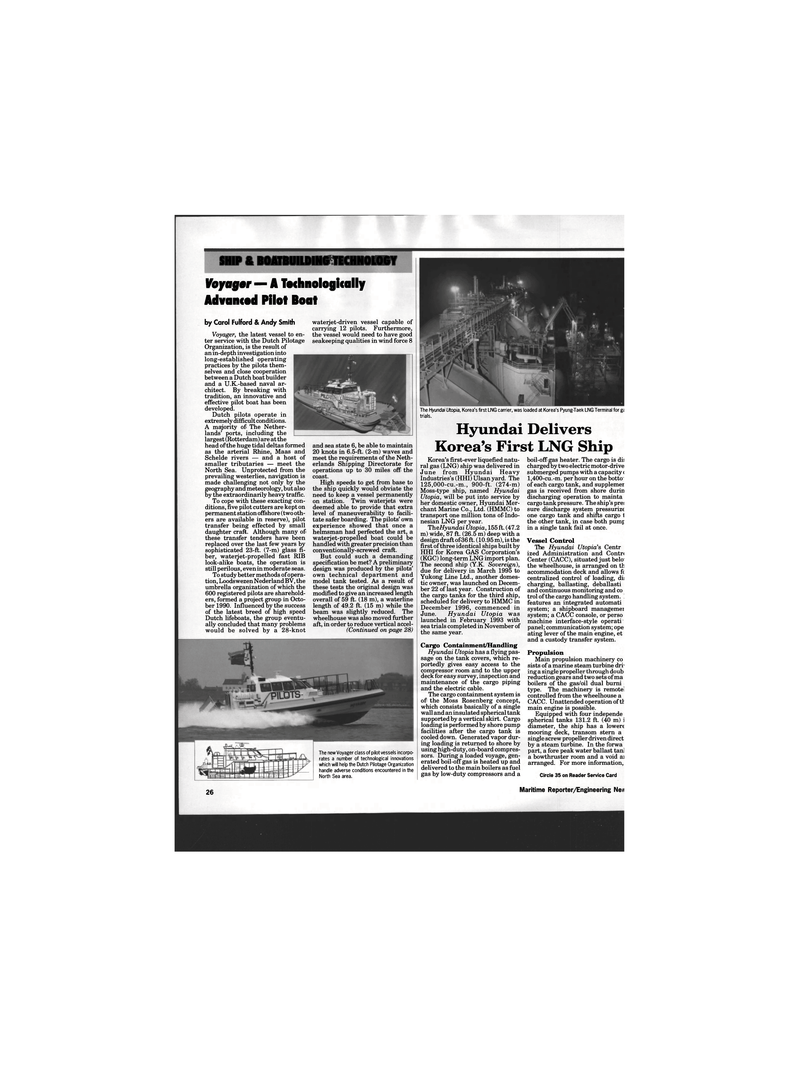
Page 24: of Maritime Reporter Magazine (July 1994)
Read this page in Pdf, Flash or Html5 edition of July 1994 Maritime Reporter Magazine
SHIP & BOATBUILDING TECHNOLOGY
Voyager — A Technologically
Advanced Pilot Boat
The Hyundai Utopia, Korea's first LNG carrier, was loaded at Korea's Pyung-Taek LNG Terminal for g; trials.
Hyundai Delivers
Korea's First LNG Ship
Korea's first-ever liquefied natu- ral gas (LNG) ship was delivered in
June from Hyundai Heavy
Industries's (HHI) Ulsan yard. The 125,000-cu.-m., 900-ft. (274-m)
Moss-type ship, named Hyundai
Utopia, will be put into service by her domestic owner, Hyundai Mer- chant Marine Co., Ltd. (HMMC) to transport one million tons of Indo- nesian LNG per year.
TheHyundai Utopia, 155ft. (47.2 m) wide, 87 ft. (26.5 m) deep with a design draft of 36 ft. (10.95 m), is the first of three identical ships built by
HHI for Korea GAS Corporation's (KGC) long-term LNG import plan.
The second ship (Y.K. Sovereign), due for delivery in March 1995 to
Yukong Line Ltd., another domes- tic owner, was launched on Decem- ber 22 of last year. Construction of the cargo tanks for the third ship, scheduled for delivery to HMMC in
December 1996, commenced in
June. Hyundai Utopia was launched in February 1993 with sea trials completed in November of the same year.
Cargo Containment/Handling
Hyundai Utopia has a flying pas- sage on the tank covers, which re- portedly gives easy access to the compressor room and to the upper deck for easy survey, inspection and maintenance of the cargo piping and the electric cable.
The cargo containment system is of the Moss Rosenberg concept, which consists basically of a single wall and an insulated spherical tank supported by a vertical skirt. Cargo loading is performed by shore pump facilities after the cargo tank is cooled down. Generated vapor dur- ing loading is returned to shore by using high-duty, on-board compres- sors. During a loaded voyage, gen- erated boil-off gas is heated up and delivered to the main boilers as fuel gas by low-duty compressors and a boil-off gas heater. The cargo is dis charged by two electric motor-drive submerged pumps with a capacity ( l,400-cu.-m. per hour on the bottoi of each cargo tank, and supplemer gas is received from shore durin discharging operation to maintai cargo tank pressure. The ship's prei sure discharge system pressurize one cargo tank and shifts cargo 1 the other tank, in case both pump in a single tank fail at once.
Vessel Control
The Hyundai Utopia's Centra ized Administration and Contri
Center (CACC), situated just belo' the wheelhouse, is arranged on tb accommodation deck and allows f( centralized control of loading, dii charging, ballasting, deballastin and continuous monitoring and coi trol of the cargo handling system. ] features an integrated automatio system; a shipboard managemei system; a CACC console, or persoi machine interface-style operatio panel; communication system; ope ating lever of the main engine, etc and a custody transfer system.
Propulsion
Main propulsion machinery coi sists of a marine steam turbine dri1 ing a single propeller through doub reduction gears and two sets of mai boilers of the gas/oil dual burnir type. The machinery is remote' controlled from the wheelhouse ar
CACC. Unattended operation of tl main engine is possible.
Equipped with four independei spherical tanks 131.2 ft. (40 m) i diameter, the ship has a lowere mooring deck, transom stern ar single screw propeller driven direct by a steam turbine. In the forwai part, a fore peak water ballast tan] a bowthruster room and a void a] arranged. For more information,
Circle 35 on Reader Service Card by Carol Fulford & Andy Smith
Voyager, the latest vessel to en- ter service with the Dutch Pilotage
Organization, is the result of an in-depth investigation into long-established operating practices by the pilots them- selves and close cooperation between a Dutch boat builder and a U.K.-based naval ar- chitect. By breaking with tradition, an innovative and effective pilot boat has been developed.
Dutch pilots operate in extremely difficult conditions.
A majority of The Nether- lands' ports, including the largest (Rotterdam) are at the head of the huge tidal deltas formed as the arterial Rhine, Maas and
Schelde rivers — and a host of smaller tributaries — meet the
North Sea. Unprotected from the prevailing westerlies, navigation is made challenging not only by the geography and meteorology, but also by the extraordinarily heavy traffic.
To cope with these exacting con- ditions, five pilot cutters are kept on permanent station offshore (two oth- ers are available in reserve), pilot transfer being effected by small daughter craft. Although many of these transfer tenders have been replaced over the last few years by sophisticated 23-ft. (7-m) glass fi- ber, waterjet-propelled fast RIB look-alike boats, the operation is still perilous, even in moderate seas.
To study better methods of opera- tion, Loodswezen Nederland BV, the umbrella organization of which the 600 registered pilots are sharehold- ers, formed a project group in Octo- ber 1990. Influenced by the success of the latest breed of high speed
Dutch lifeboats, the group eventu- ally concluded that many problems would be solved by a 28-knot
The new Voyager class of pilot vessels incorpo- rates a number of technological innovations which will help the Dutch Pilotage Organization handle adverse conditions encountered in the
North Sea area. waterjet-driven vessel capable of carrying 12 pilots. Furthermore, the vessel would need to have good seakeeping qualities in wind force 8 and sea state 6, be able to maintain 20 knots in 6.5-ft. (2-m) waves and meet the requirements of the Neth- erlands Shipping Directorate for operations up to 30 miles off the coast.
High speeds to get from base to the ship quickly would obviate the need to keep a vessel permanently on station. Twin waterjets were deemed able to provide that extra level of maneuverability to facili- tate safer boarding. The pilots' own experience showed that once a helmsman had perfected the art, a waterjet-propelled boat could be handled with greater precision than conventionally-screwed craft.
But could such a demanding specification be met? A preliminary design was produced by the pilots' own technical department and model tank tested. As a result of these tests the original design was modified to give an increased length overall of 59 ft. (18 m), a waterline length of 49.2 ft. (15 m) while the beam was slightly reduced. The wheelhouse was also moved further aft, in order to reduce vertical accel- (Continued on page 28) 26 Maritime Reporter/Engineering News

 23
23

 25
25
